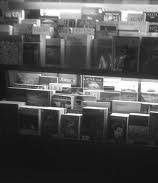What Literary Journal Should I Read?

When rifling through displays of literary magazines, I admit that they start to blur. One camp seems urbane and clubbish, while the other camp, sometimes with a vaguely agrarian name, appears to target lesser-known authors. Everyone seems to be publishing Roberto Bolaño.
I’m not an academic or lit-insider, so I don’t get the shorthand of which university’s publication is the most prestigious. Besides, I want to subscribe to something that will consistently engage me, rather than poncify my coffee table. Kenyon, Antioch, Virginia? The signifier goes right over my head. Last time I browsed, I found myself reaching for Eastern Kentucky University’s journal purely for its name: Jelly Bucket.
Here’s what I’m after: a less-commercial magazine that offers serious fiction and nonfiction, but balances its earnest purpose with a sense of pleasure, even fun. Meaty articles and interviews but not too insider-baseball. A journal that regularly includes new authors as well as translated work, to help me stay clear of reading ruts. Happy to see some photography or art. Poetry and criticism welcome in smaller measures. In each issue, something delightfully askew.
How about all of you? Which journal do you love and why? What do you look for in a literary quarterly?
Below are my first impressions of some current contenders, running through their winter issues. (Since as Peter Pan says, first impressions are awfully important.) Are there any longtime subscribers to weigh in, or other publications you’d suggest?
$40/year
Tally: 4 fiction authors, 6 poets, 2 interviews (Jeffrey Eugenides and Alan Hollinghurst), 1 memoir, 1 “curated porfolio” of full-color images.
Cover: An abstract pink and purple design unfortunately resembling a doily.
First Take: Rah-rah over their installments of Bolaño’s “The Third Reich.” A couple of new writers but mostly big guns I’ve at least heard of. Liked the introductions to the interviews, which include tidbits on the circumstances of the Q&As, and the interviews themselves. Both interviewers asked some basic life and process questions (tell me about your childhood, what are your writing rituals) but both authors answered thoughtfully. Learned that Hollinghurst’s neighbor, Baron Berners, used to dye his pigeons rainbow colors, and that Eugenides thinks that “cigars are the perfect literary drug.” Most of the lightness or humor seems to spring from these interviews.
Lagniappe: The contributor bio for Gottfried Benn: “a German poet, essayist, and venereal-disease specialist.” That’s one helluva combination.
$30/year
Tally: 10 fiction authors, 18 poets, 2 essayists, 5 reviewers, 1 archive selection.
Cover: Vaguely organic, bubbly print.
First Take: Intrigued by their practice of having a guest editor for every edition. (This one was Alice Hoffman.) Does that result in widely varying issues? Glad to see they have an emerging writers contest, to keep fresh blood in the pages. While the publication emphasizes up-and-coming writers, I had to roll my eyes at the James Franco’s piece and his inevitable “I hit a deer while driving” story.
Lagniappe: In the archive selection, an interview with poet Elizabeth Bishop, Bishop recommends putting a peppermint stick in a lemon half and sucking it: “Very good.” She then suddenly says, “I think I’ve been awfully, oh, asleep my whole life.” Surprising, coming from such a trenchant observer.
$36/year
Tally: 5 fiction authors, 10 poets, 1 memoirist, 1 essayist, 1 “illustrated guide” with color photos.
Cover: A street-scene photo.
First Take: Bills itself as “art & argument, fact & fiction,” which piqued my fancy but I didn’t see much argument. More Bolaño, this time poetry. Off-white paperstock made it feel a bit time-worn. Most interesting section was non-fiction: designer Eva Zeisel’s reminiscences of her time in a Russian prison camp.
Lagniappe: 2 reproduced cards from H. L. Mencken, on which he types personal observations such as “My vanity is excessive. Wherever I sit is the head of the table.”
$24.95/year
Tally: 5 fiction authors, 7 poets, 13 features writers / essayists, 1 interview (Aimee Bender).
Cover: Illustrated with seashells, with a small female nude-on-the-half-shell.
First Take: Like “Granta,” these issues have themes. The 50th issue revolves around Beauty, in an enjoyable loose, oblique way. There’s a translated excerpt from Michel Houellebecq’s latest, “The Map and the Territory” (dinner-party bragging rights). Subjects range farther afield, with essays on a Mumbai bar dancer and jazz pianist Sonny Clark. A welcome dash of humor in the piece about Burt Reynolds’s book of letters, “Hot Line.”
Lagniappe: In an essay about her day spent with James Salter, Sonya Chung reveals one of the author’s surprising favorites, Nora Ephron. “She has unclouded vision,” Salter says. How many times do you think he’s watched “When Harry Met Sally”?











